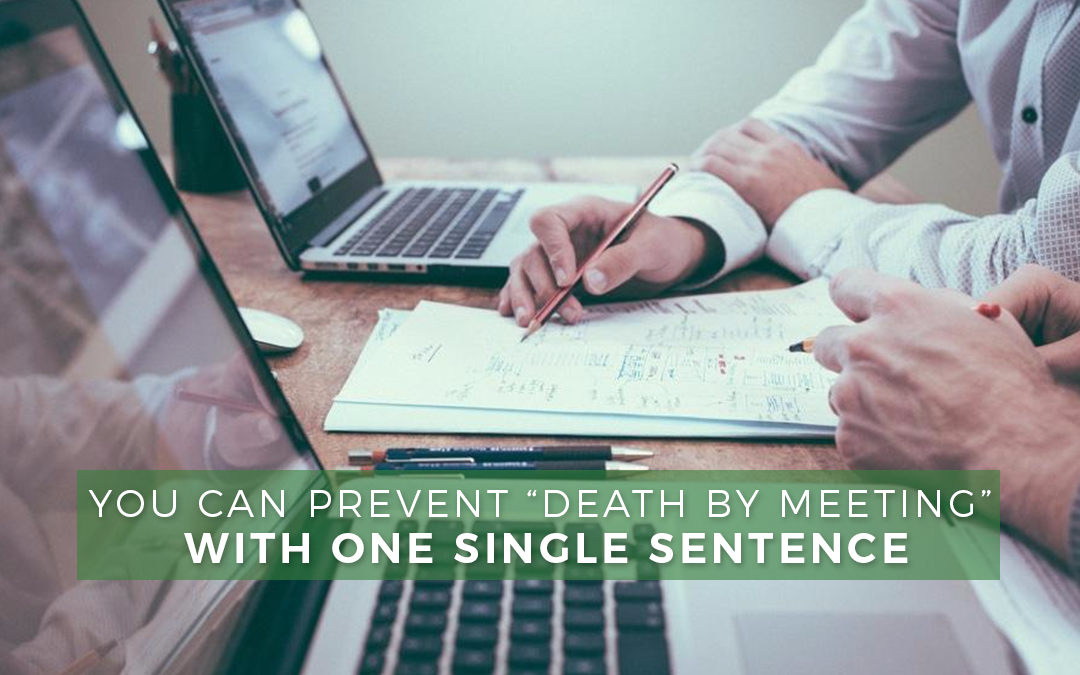Have you ever heard of ‘death by meeting’?
If you work in an office, I’m sure you’ve heard of it and lived it.
You know what it looks like: More than half of your workday devoted to meetings (a lot more than half). It looks like 15-point agendas and then a 27-part email string with notes and follow-up questions.
It’s death by meeting and death to productivity.
And I think I know the primary culprit: the agenda.
Does that seem counterintuitive? Every meeting needs an agenda, right? Without an agenda, we wouldn’t know what to talk about!
Hear me out. Agendas are nothing more than a series of topics you want to discuss; they’re the “doing” of meetings. Agendas don’t provide direction or focus – and if you don’t know where you’re going, you could wind up anywhere.
We can exponentially increase the productivity of our meetings if we put the focus on a TARGET instead of an AGENDA.
Quite simply, the target is where we want to end up at the end of the meeting; it’s a clear, crisp, cohesive statement of what success will look like. It drives decision making and group discussion a million times more effectively than an agenda. Target-driven meetings also help you build executive presence—a must-have for driving clarity and direction with your team.
Let’s compare an agenda….
1. Marketing budget
2. New partnership opportunities
3. High potential talent discussion
4. Board meeting presentation finalization
….to a target:
By the end of this meeting, we will have identified 3 -5 actions we can take as a leadership team to develop our front-line managers.
See the difference? When we know where we’re going, we’re less likely to get sidetracked or distracted.
How to Structure More Effective Meetings with a Target-Based Approach
1. Write your Target in this format: By the end of the meeting we will _______. Declare the “finish line” for the meeting. What would a successful meeting look like? How will we know if we succeeded in using our time wisely?
2. Review your Target with meeting participants at the start of the meeting. Get agreement on your target before you dive in – if they’re not on board, they’ll pull the whole meeting off course.
3. Even better, when you initially invite people to the meeting, include the target in the Outlook invite, then they’ll know what to expect and come prepared. As a meeting participant, I sure would appreciate knowing what the meeting is about before I show up.
4. Of course, you can include an agenda or key topics but make sure the agenda items are moving your team in the direction of the target.
5. Don’t be afraid to speak up if the meeting is veering off course from the target. You have permission to do this if everyone agreed to the target up front. We all prefer shorter meetings to longer ones – help your team stay focused.
6. Spend the last few minutes of the meeting deciding if your target was met or if you need a follow-up meeting. Document any next steps.
Stop quietly suffering! Let’s take back our meetings, inject productivity using targets and make them worth the investment of everyone’s time.
Ready to run more effective meetings that don’t drain your team? Our Leadership EDGE program helps you cut through the noise and lead with intention—whether in meetings, strategy sessions, or big-picture planning. Or contact us for help tailoring a solution for your team.



